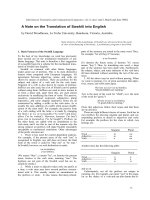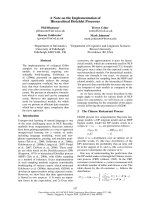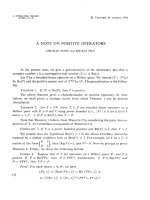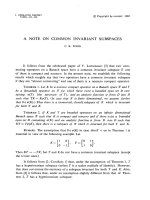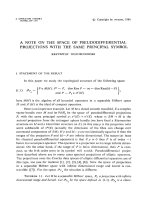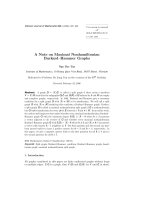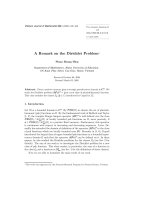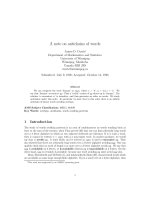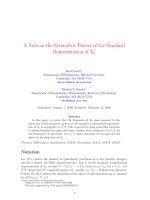Báo cáo toán học: "A note on the number of (k, )-sum-free sets" potx
Bạn đang xem bản rút gọn của tài liệu. Xem và tải ngay bản đầy đủ của tài liệu tại đây (109.63 KB, 8 trang )
A note on the number of
(k, )-sum-free sets
Tomasz Schoen
Mathematisches Seminar Universit¨at zu Kiel
Ludewig-Meyn-Str. 4,
24098 Kiel, Germany
and
Department of Discrete Mathematics
Adam Mickiewicz University
Pozna´n, Poland
Abstract
AsetA ⊆ N is (k, )-sum-free, for k, ∈ N, k>,ifitcontainsno
solutions to the equation x
1
+ ···+ x
k
= y
1
+ ···+ y
.Letρ = ρ(k − )
be the smallest natural number not dividing k − ,andletr = r
n
,
0 ≤ r<ρ, be such that r ≡ n (mod ρ). The main result of this
note says that if (k − )/ is small in terms of ρ, then the number of
(k, )-sum-free subsets of [1,n]isequalto(ϕ(ρ)+ϕ
r
(ρ)+o(1))2
n/ρ
,
where ϕ
r
(x) denotes the number of positive integers m ≤ r relatively
prime to x and ϕ(x)=ϕ
x
(x).
Submitted: February 15, 1999; Accepted: May 23, 2000.
1991 Mathematics Subject Classification: 11B75, 11P99.
AsetA of positive integers is (k,)-sum-free for k, ∈ N, k>,ifthere
are no solutions to the equation x
1
+ ···+ x
k
= y
1
+ ···+ y
in A. Denote
by SF
n
k,
the number of (k, )-sum-free subsets of [1,n]. Since the set of
1
the electronic journal of combinatorics 7 (2000), #R30 2
odd numbers is (2, 1)-sum-free we have SF
n
2,1
≥ 2
(n+1)/2
. In fact Erd˝os and
Cameron [6] conjectured SF
n
2,1
= O(2
n/2
). This conjecture is still open and
the best upper bounds for SF
n
2,1
given independently by Alon [1] and Calkin
[3], say that, for ≥ 1,
SF
n
+1,
≤SF
n
2,1
= O(2
n/2+o(n)
) .
For ≥ 3 this bound was recently improved by Bilu [2] who proved that in
this case SF
n
+1,
=(1+o(1))2
(n+1)/2
.
Thecaseofk being much larger than was treated by Calkin and Taylor
[4]. They showed that for some constant c
k
the number of (k, 1)-sum-free
subsets of [1,n] is at most c
k
2
k−1
k
n
, provided k ≥ 3. Furthermore, Calkin and
Thomson proved [5] that for every k and with k ≥ 4 − 1
SF
n
k,
≤ c
k
2
(k−)n/k
.
In order to study the behaviour of SF
n
k,
let us observe first that there are
two natural examples of large (k,)-sum-free subsets of the interval [1,n]:
{n/k +1, ,n}
and
{m ∈{1, 2, ,n} : m ≡ r (mod ρ)} ,
where gcd(r, ρ)=1andρ = ρ(k −)=min{s ∈ N : s does not divide k − }.
Thus,
SF
n
k,
≥ max
2
n/ρ
, 2
(k−)n/k
.
In this note we study the case k<
ρ
ρ−1
so that 2
n/ρ
> 2
(k−)n/k
,andwe
may expect SF
n
k,
to be close to 2
n/ρ
. Indeed, we will prove as our main
result that for fixed k and there exists a bounded function ξ = ξ(n)such
that
SF
n
k,
=(ξ + o(1))2
n/ρ
provided k<
1 −
c−1
cρ−1
ρ
ρ−1
,wherec =
1+ln 2
2ln2
,and is sufficiently large.
For every natural numbers x, r let ϕ
r
(x) be the number of positive inte-
gers m ≤ r relatively prime to x and let ϕ(x) abbreviate ϕ
x
(x). For a finite
set A of integers A define:
the electronic journal of combinatorics 7 (2000), #R30 3
d(A)=gcd(A),d
(A)=d(A − A),
Λ(A)=maxA − minA, Λ
(A)=Λ(A)/d
(A).
Furthermore, let
κ(A)=
Λ
(A) − 1
|A|−2
,θ(A)=
max(A)
Λ(A)
,
T (A)=(|A|−2)(κ(A) +1− κ(A)) + 1
and
hA = {a
1
+ ···+ a
h
: a
1
, ,a
h
∈ A}.
For a specified set A, we simply write d, d
, Λ, etc.
Our approach is based on a remarkable result of Lev [7]. Using an affine
transformation of variables his theorem can be stated as follows.
Theorem 1. Let A be a finite set of integers and let h be a positive integer
satisfying h>2κ − 1. Then there exists an integer s such that
{sd
, ,(s + t)d
}⊆hA ,
for t =(h − 2κ)Λ
+2κT.
Lemma 1. Let A be a finite set of integers and let h be a positive integer
satisfying h>2κ − 1. Then {0,d
, ,td
}⊆hA − hA, where t ≥ (h +1−
2κ)Λ
.
Proof. Theorem 1 implies that hA contains t =(h − 2κ)Λ
+2κT +1
consecutive multiples of d
,sothat
{0, ,td
}⊆hA − hA.
Furthermore,
t =(h−2κ)Λ
+2κT =(h+2−2κ−τ)Λ
+
2κ(κ −κ)+2κ(κ − 1)
κ
,
where
τ =
2(κ −κ)(κ +1− κ)
κ
.
Since τ ≤ 1andκ ≥ 1, the result follows.
the electronic journal of combinatorics 7 (2000), #R30 4
Lemma 2. Let A ⊆ [1,n] be a (k, )-sum-free set, and let r be the residue
class mod d
containing A. Assume that either
d
<ρ, (1)
or
(k − )r ≡ 0(modd
). (2)
Then
κ ≥
k +1− (k − )θ
2
. (3)
Proof. We may assume that >2κ − 1, otherwise the assertion is obvious.
By Lemma 1 we have
{0,d
, ,td
}⊆A − A,
where t ≥ ( +1− 2κ)Λ
. Put m =minA. Then any of the assumptions (1),
(2) implies d
|(k − )m.SinceA is a (k, )-sum-free set, it follows that
(k − )m>td
≥ ( +1− 2κ)Λ,
which gives the required inequality.
Theorem 2. Assume that k>≥ 3 are positive integers satisfying
k −
2
· max
2≤x≤
+1
2
ln x
x
+
x−1
x
ln
x
x−1
k+1
2
− x
<
ln 2
ρ
. (4)
Then
SF
n
k,
=(ϕ + ϕ
r
+ o(1))2
n/ρ
, (5)
where 0 ≤ r<ρand r ≡ n (mod ρ).
Proof. In order to obtain the lower bound let us observe that there are
exactly ϕ maximal (k, )-sum-free arithmetic progressions with the difference
ρ. Precisely ϕ
r
of them have length n/ρ and ϕ − ϕ
r
are of length n/ρ.
Since these progressions are pairwise disjoint, there are at least
(ϕ + ϕ
r
)2
n/ρ
the electronic journal of combinatorics 7 (2000), #R30 5
(k, )-sum-free subsets of [1,n].
Now we estimate SF
n
k,
from above. First consider (k, )-sum-free sets
satisfying neither (1), nor (2). Plainly each of these is contained in a residue
class r mod d
,whered
≥ ρ and (k − )r ≡ 0modd
. If d
= ρ, by the same
argument as above, exactly (ϕ + ϕ
r
)2
n/ρ
(k, )-sum-free subsets of [1,n]
are contained in arithmetic progression r mod ρ, where (k − )r ≡ 0modρ.
If d
>ρthen every progression r mod d
consists of at most n/(ρ +1)
elements hence it contains no more than 2
n/(ρ+1)
subsets. Furthermore we
have less than n
2
possible choices for the pair (d
,ρ), hence there are at most
2n
2
2
n/(ρ+1)
such (k, )-sum-free sets. Thus, the number of (k, )-sum-free sets
satisfying neither (1), nor (2) does not exceed
(ϕ + ϕ
r
)2
n/ρ
+2n
2
2
n/(ρ+1)
.
To complete the proof it is sufficient to show that the number of (k, )-
sum-free subsets of [1,n] satisfying either (1) or (2) is o(2
n/ρ
). Denote by B
the set of all such subsets, and let
B(K, L, M)={A ∈B: |A| = K, Λ(A)=L, max A = M},
so that
B =
1≤K≤L+1≤M≤n
B(K, L, M).
We will prove that
max
1≤K≤L+1≤M≤n
|B(K, L, M)|≤e
µn+O(ln n)
, (6)
where µ is the left-hand side of (4) which in turn implies that
|B| = o(2
n/ρ
). (7)
Let us define the following decreasing function x(t)=(k +1−(k −)t)/2.
Note that x(1) = ( +1)/2,x(t
2
)=2andx(t
1
)=1, where
t
2
=
k − 3
k −
≥ 1andt
1
=
k − 1
k −
.
Furthermore, put
H(x)=
ln x
x
+
x − 1
x
ln
x
x − 1
.
the electronic journal of combinatorics 7 (2000), #R30 6
Observe that H is increasing on (1, 2] and decreasing on [2, ∞). Moreover
µ =max
1≤t≤t
2
H(x(t))
t
and
max
1≤t≤t
1
x≥x(t)
H(x)
t
= µ. (8)
Indeed, if 1 ≤ t ≤ t
2
then x ≥ x(t) ≥ 2andH(x)/t ≤ H(x(t))/t ≤ µ. If
t
2
≤ t ≤ t
1
then H(x)/t ≤ H(2)/t
2
= H(x(t
2
))/t
2
≤ µ.
Now we are ready to prove (7). For a fixed triple K, L, M with 1 ≤ K ≤
L +1≤ M ≤ n put
θ =
M
L
,κ=
L − 1
K − 2
.
Then κ(A) ≤ κ and θ(A)=θ for any A ∈B(K, L, M). By Lemma 2 we have
κ ≥ x(θ). Since κ ≥ 1 by definition, we infer that H(κ)/θ ≤ µ by (8). Using
Stirling’s formula we obtain
|B(K, L, M)|≤
L − 1
K − 2
=exp(H(κ)L + O(ln L))
=exp
H(κ)
θ
M + O(ln n)
≤ exp(µn + O(ln n)).
Thus
|B| ≤ n
3
exp(µn + O(ln n)),
which completes the proof of Theorem 2.
Corollary 1. The estimate (5) holds, provided k>≥ 3 and
max
1+ln 2
2
(k − ), 2(1 + ln
+1
2
)
+1
<
ln 2
ρ
. (9)
the electronic journal of combinatorics 7 (2000), #R30 7
Proof. We need to show that the left-hand side of (4) is not larger than the
left-hand side of (9). Since ln(1 + u) ≤ u for u ≥ 0, we have
x − 1
x
ln
x
x − 1
≤
1
x
for x ≥ 1, so that
µ ≤
k − l
2
max
2≤x≤
+1
2
1+lnx
x(
k+1
2
− x)
. (10)
Furthermore,
max
2≤x≤
k−
2
1+lnx
x(
k+1
2
− x)
≤
2
+1
max
2≤x≤
+1
2
1+lnx
x
=
1+ln2
+1
,
max
k−
2
≤x≤
+1
2
1+lnx
x(
k+1
2
− x)
≤
1+ln
+1
2
min
k−
2
≤x≤
+1
2
x(
k+1
2
− x)
=4
1+ln
+1
2
(k − )( +1)
.
Combining the above inequalities with (10), the result follows.
Let us conclude this note with some further remarks on the range of k
and satisfying (4). If
1+ln 2
2
(k −) ≤ 2(1+ln
+1
2
), that is (k −) ≤
4
1+ln 2
(1+
ln
+1
2
), then by Corollary 1 (4) holds, provided ≥
2
ln 2
1+ln
+1
2
ρ(k − ).
By the prime number theorem, ρ(n) ≤ (1 + o(1)) ln n, hence the inequality
≥
2
ln 2
1+ln
+1
2
ρ(k−) is fulfilled for every sufficiently large .If
1+ln 2
2
(k−
) ≥ 2(1 + ln
+1
2
) then (4) holds for every k and such that <k<
cρ
cρ−1
=
1 −
c−1
cρ−1
ρ
ρ−1
, where c =
1+ln 2
2ln2
. Thus, from Theorem 2, one can deduce
that there exists an absolute constant
0
such that
SF
n
k,
=(ϕ + ϕ
r
+ o(1))2
n/ρ
,
provided
0
<<k<
1 −
c−1
cρ−1
ρ
ρ−1
.
Acknowledgments. I would like to thank referees for many valuable com-
ments. Due to their suggestions we were able to prove the main result of the
note in its present sharp form.
the electronic journal of combinatorics 7 (2000), #R30 8
References
[1] N. Alon, Independent sets in regular graphs and sum-free sets of finite
groups, Israel J. Math. 73 (1991), 247–256.
[2] Yu. Bilu, Sum-free sets and related sets, Combinatorica 18 (1998), 449–
459.
[3]N.J.Calkin,On the number of sum-free sets, Bull. Lond. Math. Soc.
22 (1990), 141–144.
[4] N. J. Calkin, A. C. Taylor: Counting sets of integers, no k of which sum
to another, J. Number Theory 57 (1996), 323–327.
[5] N. J. Calkin, J. M. Thomson, Counting generalized sum-free sets,J.
Number Theory 68 (1998), 151–160.
[6] P.J.Cameron,P.Erd˝os, On the number of sets of integers with various
properties, in R. A. Mollin (ed.), Number Theory: Proc. First Conf.
Can. Number Th. Ass., Banff, 1988, de Gruyter, 1990, 61–79.
[7] V.F.Lev,Optimal representation by sumsets and subset sums, J. Num-
ber Theory 62 (1997), 127–143.
